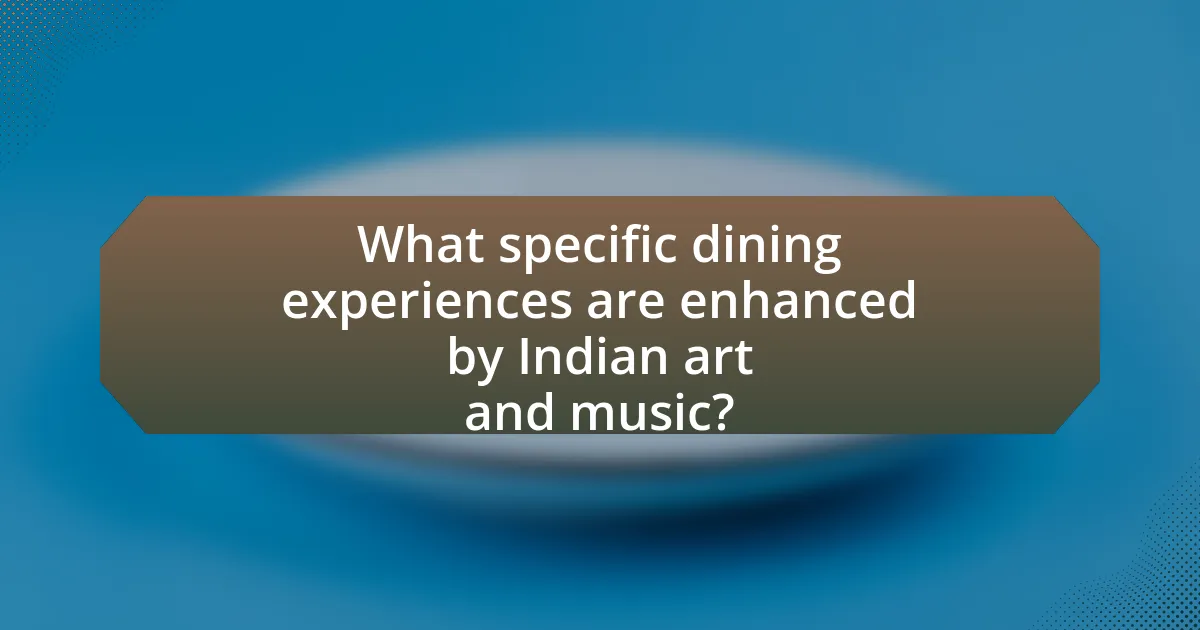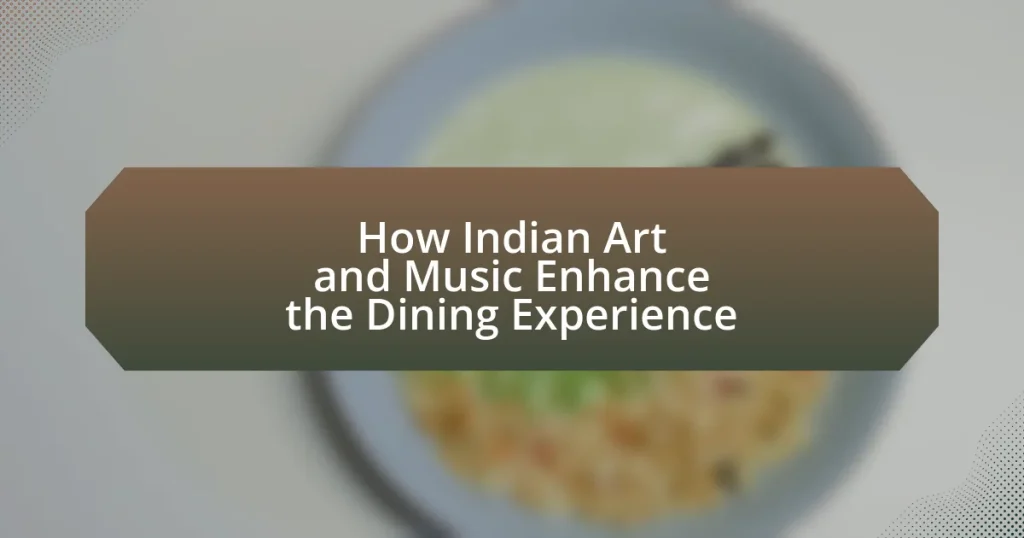The article explores how Indian art and music significantly enhance the dining experience by creating an immersive atmosphere that engages the senses. It details the key elements of Indian art, such as intricate tableware and vibrant textiles, and their impact on visual ambiance. Additionally, it examines the role of Indian music in fostering emotional connections and influencing diners’ perceptions of food. The integration of these cultural elements not only elevates the sensory experience but also reflects India’s rich heritage, making dining a holistic cultural celebration. The article also discusses best practices for restaurants to effectively incorporate art and music into their dining environments.

How does Indian art and music contribute to the dining experience?
Indian art and music significantly enhance the dining experience by creating an immersive atmosphere that engages the senses. The vibrant colors and intricate designs of Indian art, such as traditional paintings and decorative table settings, stimulate visual interest and evoke cultural heritage. Simultaneously, Indian music, characterized by its diverse rhythms and melodies, fosters a lively ambiance that can elevate mood and encourage social interaction among diners. Research indicates that environments enriched with art and music can lead to increased satisfaction and enjoyment during meals, as they contribute to a holistic sensory experience that complements the flavors of the cuisine.
What are the key elements of Indian art that enhance dining?
The key elements of Indian art that enhance dining include intricate tableware, vibrant textiles, and traditional motifs. Intricate tableware, such as hand-painted ceramics and brass utensils, not only serve functional purposes but also add aesthetic value to the dining experience, reflecting India’s rich craftsmanship. Vibrant textiles, including tablecloths and napkins adorned with traditional patterns, create an inviting atmosphere that complements the meal. Traditional motifs, often inspired by nature and mythology, are incorporated into decor and serving dishes, enriching the cultural context of the dining experience. These elements collectively elevate the sensory experience of dining, making it not just a meal but a celebration of Indian heritage.
How do colors and patterns in Indian art influence ambiance?
Colors and patterns in Indian art significantly influence ambiance by evoking emotions and setting the mood in a space. The vibrant colors, such as deep reds, bright yellows, and rich blues, create a lively atmosphere that can enhance social interactions and stimulate appetite, which is particularly beneficial in dining settings. Patterns, often intricate and symbolic, add depth and cultural context, making the environment feel more inviting and immersive. For instance, traditional motifs like paisleys and mandalas can create a sense of harmony and balance, contributing to a serene dining experience. Studies have shown that color psychology indicates warm colors can increase energy levels, while cooler tones promote relaxation, thus directly impacting how individuals perceive their dining experience.
What role do traditional motifs play in the dining atmosphere?
Traditional motifs significantly enhance the dining atmosphere by creating a culturally immersive experience that reflects heritage and tradition. These motifs, often derived from historical art forms, contribute to the ambiance by evoking a sense of place and identity, which can elevate the overall dining experience. For instance, the use of intricate patterns and designs in tableware or decor can stimulate visual interest and foster a connection to cultural narratives. Research indicates that environments enriched with traditional elements can positively influence diners’ emotional responses, leading to increased satisfaction and enjoyment during meals.
How does Indian music complement the dining experience?
Indian music enhances the dining experience by creating an immersive atmosphere that engages diners emotionally and culturally. The rhythmic patterns and melodic structures of Indian music, such as classical ragas, are designed to evoke specific moods, which can elevate the enjoyment of food. Studies have shown that music influences taste perception; for instance, a study published in the Journal of Consumer Research indicates that background music can enhance the flavor experience, making food taste better. Additionally, traditional Indian instruments like the sitar and tabla add authenticity to the dining experience, connecting diners to India’s rich cultural heritage. This combination of emotional engagement and cultural authenticity makes Indian music a vital complement to the dining experience.
What types of Indian music are commonly played in dining settings?
Indian classical music, instrumental music, and soft fusion genres are commonly played in dining settings. Indian classical music, such as Hindustani and Carnatic styles, provides a serene atmosphere that enhances the dining experience. Instrumental music, featuring traditional instruments like the sitar and tabla, creates a soothing background that complements the culinary offerings. Additionally, soft fusion genres that blend Indian music with contemporary styles are increasingly popular, appealing to diverse audiences while maintaining a relaxed ambiance. These musical choices contribute to a culturally rich and enjoyable dining environment.
How does the tempo of music affect diners’ moods and experiences?
The tempo of music significantly influences diners’ moods and experiences by affecting their emotional state and dining behavior. Research indicates that faster tempos can create a lively atmosphere, encouraging quicker eating and social interaction, while slower tempos promote relaxation and longer meal durations. A study published in the Journal of Consumer Research found that diners exposed to fast-paced music tended to order more food and beverages, enhancing their overall dining experience. Conversely, slower music led to increased satisfaction and a more leisurely pace, allowing diners to savor their meals. This relationship between music tempo and dining behavior underscores the importance of carefully selecting music to enhance the overall dining experience.
Why is the integration of art and music important in Indian dining?
The integration of art and music is important in Indian dining because it enhances the overall sensory experience, creating a more immersive and enjoyable atmosphere. Indian culture places significant emphasis on the aesthetic presentation of food, where visual art forms, such as traditional table settings and decorative elements, complement the culinary experience. Additionally, music, often rooted in classical or folk traditions, enriches the dining environment by evoking emotions and fostering a sense of community among diners. Studies have shown that music can influence taste perception, making flavors more pronounced and enjoyable. Therefore, the combination of art and music not only elevates the dining experience but also reflects the rich cultural heritage of India.
How does the combination of art and music create a holistic experience?
The combination of art and music creates a holistic experience by engaging multiple senses simultaneously, enhancing emotional responses and overall enjoyment. When art, such as visual displays or decor, is paired with music, it fosters an immersive environment that stimulates both sight and sound, leading to a deeper connection with the experience. Research indicates that environments enriched with both art and music can elevate mood and increase satisfaction; for instance, a study published in the Journal of Consumer Research found that background music can enhance the perception of food quality and dining atmosphere. This synergy between art and music not only enriches the sensory experience but also promotes a memorable and cohesive atmosphere, particularly in settings like dining, where ambiance plays a crucial role in customer satisfaction.
What cultural significance do art and music hold in Indian dining traditions?
Art and music hold profound cultural significance in Indian dining traditions by enhancing the sensory experience and fostering social connections. The intricate designs of traditional Indian tableware and the vibrant decor reflect the rich heritage and regional diversity, creating an inviting atmosphere that elevates the meal. Additionally, live music or traditional songs often accompany dining, promoting a sense of celebration and community. For instance, during festivals, specific musical genres like classical or folk are played, which not only entertain but also connect diners to their cultural roots. This integration of art and music into dining practices underscores the importance of communal eating and the celebration of culinary heritage in Indian culture.

What specific dining experiences are enhanced by Indian art and music?
Indian art and music enhance specific dining experiences by creating an immersive cultural atmosphere that elevates the enjoyment of food. For instance, traditional Indian music, such as classical ragas, can complement the flavors of a meal, enhancing the sensory experience through rhythm and melody. Additionally, visual elements like intricate Indian art and decor, including vibrant paintings and sculptures, contribute to a visually stimulating environment that engages diners and reflects the rich heritage of Indian culture. Studies have shown that multisensory experiences, including music and art, can significantly enhance customer satisfaction and overall dining enjoyment, making the meal not just about food but a holistic cultural experience.
How do Indian festivals influence dining experiences through art and music?
Indian festivals significantly enhance dining experiences through the integration of art and music, creating a vibrant atmosphere that elevates communal meals. During festivals like Diwali and Holi, traditional music and dance performances often accompany feasts, fostering a sense of celebration and togetherness. For instance, the use of folk music and classical instruments during these gatherings not only entertains but also reflects the cultural heritage associated with the cuisine being served. Additionally, artistic presentations of food, such as intricate rangoli designs or decorative thalis, further enrich the dining experience, making meals visually appealing and culturally immersive. This combination of sensory elements—taste, sound, and sight—creates a holistic dining experience that is deeply rooted in Indian traditions and enhances the enjoyment of communal eating.
What are some examples of festival-themed dining events?
Examples of festival-themed dining events include Diwali dinner celebrations, where traditional Indian dishes are served alongside cultural performances, and Holi brunches featuring vibrant colors and festive foods. These events often incorporate live music and dance, enhancing the overall dining experience by immersing guests in the cultural significance of the festivals. For instance, during Diwali, restaurants may offer special menus that highlight regional delicacies, while live classical music can create an authentic atmosphere.
How does live music during festivals enhance the dining atmosphere?
Live music during festivals enhances the dining atmosphere by creating an engaging and vibrant environment that stimulates the senses. The presence of live performances encourages social interaction among diners, fostering a sense of community and shared experience. Research indicates that music can influence mood and perception; for instance, a study published in the Journal of Consumer Research found that background music can enhance the enjoyment of food and drink, leading to increased satisfaction and longer dining durations. This combination of auditory stimulation and culinary enjoyment contributes to a memorable dining experience, making festivals more appealing to attendees.
What role does art play in themed Indian restaurants?
Art plays a crucial role in themed Indian restaurants by creating an immersive cultural experience that enhances the overall dining atmosphere. The visual elements, such as traditional paintings, sculptures, and decor, reflect India’s rich heritage and invite diners to engage with the culture. For instance, the use of vibrant colors and intricate designs in artwork can evoke the essence of Indian festivals and traditions, making the dining experience more memorable. Additionally, art can serve as a conversation starter, allowing patrons to connect over shared cultural interests, thereby enriching their social experience.
How do decor and artwork reflect the restaurant’s culinary theme?
Decor and artwork in a restaurant reflect the culinary theme by visually representing the cultural and regional elements of the cuisine served. For instance, in an Indian restaurant, vibrant colors, traditional motifs, and intricate patterns in decor can evoke the rich heritage of Indian culture, while artwork featuring local landscapes or historical figures can connect diners to the origins of the dishes. This alignment between decor and culinary theme enhances the overall dining experience by immersing guests in the cultural context of the food, making it more meaningful and memorable.
What impact does themed music have on diners’ perceptions of the cuisine?
Themed music significantly influences diners’ perceptions of cuisine by enhancing the overall dining experience and shaping emotional responses. Research indicates that music can evoke specific cultural associations, which in turn affect how diners interpret and enjoy their meals. For instance, a study published in the Journal of Consumer Research found that diners exposed to Indian music while eating Indian cuisine rated their meals as more authentic and flavorful compared to those who listened to neutral or non-themed music. This suggests that themed music not only complements the food but also reinforces cultural identity, leading to a more immersive and satisfying dining experience.

How can restaurants effectively incorporate Indian art and music into their dining experiences?
Restaurants can effectively incorporate Indian art and music into their dining experiences by integrating traditional Indian decor and live performances into their ambiance. Utilizing vibrant Indian artwork, such as paintings, sculptures, and textiles, can create an immersive environment that reflects India’s rich cultural heritage. For instance, displaying works from renowned Indian artists or local artisans can enhance the visual appeal and provide guests with a cultural context.
Additionally, featuring live Indian music, such as classical or folk performances, can elevate the dining experience by creating an engaging atmosphere. Research indicates that music can influence dining behavior and enhance customer satisfaction, making it a valuable addition to the restaurant experience. By scheduling performances during peak dining hours or special events, restaurants can attract more patrons and create memorable experiences that resonate with the cultural theme.
What are best practices for selecting art and music for dining environments?
Best practices for selecting art and music for dining environments include aligning the aesthetic and auditory elements with the restaurant’s theme and target audience. For instance, Indian restaurants often benefit from incorporating traditional Indian art and music, which can enhance the cultural experience and create an immersive atmosphere. Research indicates that the right combination of visual and auditory stimuli can significantly influence diners’ perceptions and satisfaction levels, as evidenced by a study published in the Journal of Consumer Research, which found that congruent music and decor can enhance the overall dining experience and increase the time spent in the establishment.
How can restaurants choose art that resonates with their target audience?
Restaurants can choose art that resonates with their target audience by conducting thorough research on the demographics, preferences, and cultural backgrounds of their clientele. Understanding the target audience allows restaurants to select artwork that reflects their values and interests, enhancing the overall dining experience. For instance, a study by the National Endowment for the Arts indicates that art can significantly influence customer satisfaction and emotional connection to a space. By incorporating local Indian art forms, such as traditional paintings or sculptures, restaurants can create an authentic atmosphere that appeals to both local patrons and tourists seeking cultural experiences.
What considerations should be made when selecting music playlists?
When selecting music playlists for enhancing the dining experience, consider the ambiance, tempo, and cultural relevance of the music. The ambiance should align with the theme of the dining environment; for instance, soft instrumental music can create a relaxed atmosphere, while upbeat tracks may energize a lively setting. Tempo is crucial as it influences the pace of dining; slower tempos can encourage leisurely meals, while faster tempos may promote quicker dining. Cultural relevance is particularly important in the context of Indian art and music, as incorporating traditional Indian music can enhance authenticity and enrich the overall experience. Research indicates that music can significantly affect mood and behavior in dining settings, with studies showing that appropriate music can increase customer satisfaction and prolong dining duration.
How can restaurants create a cohesive experience with art and music?
Restaurants can create a cohesive experience with art and music by integrating visual and auditory elements that reflect the cultural themes of their cuisine. For instance, Indian restaurants can display traditional Indian art, such as paintings or sculptures, while playing classical Indian music or contemporary fusion tracks that resonate with the dining atmosphere. This alignment enhances the sensory experience, making it more immersive for patrons. Research indicates that environments combining visual and auditory stimuli can significantly influence customer satisfaction and perceived value, as seen in studies published in the Journal of Consumer Research, which highlight the impact of congruent sensory experiences on dining enjoyment.
What strategies can be employed to synchronize art displays with music?
To synchronize art displays with music, one effective strategy is to align the visual elements of the art with the rhythm and mood of the music. This can be achieved by selecting artwork that reflects the themes or emotions conveyed in the musical piece, creating a cohesive sensory experience. For instance, during a traditional Indian dining experience, vibrant colors and dynamic patterns in the artwork can complement the lively beats of Indian classical or folk music, enhancing the overall ambiance. Research indicates that multisensory integration, where visual and auditory stimuli are harmonized, can significantly elevate the dining experience by fostering a deeper emotional connection to the environment.
How can staff training enhance the integration of art and music in service?
Staff training can enhance the integration of art and music in service by equipping employees with the skills to effectively incorporate these elements into the customer experience. Training programs can focus on the cultural significance of Indian art and music, teaching staff how to create an immersive atmosphere that resonates with diners. For example, research indicates that environments enriched with art and music can improve customer satisfaction and engagement, leading to increased repeat business. By understanding the emotional impact of these elements, trained staff can curate experiences that not only reflect the essence of Indian culture but also elevate the overall dining experience.
What tips can enhance the overall dining experience through art and music?
To enhance the overall dining experience through art and music, integrating traditional Indian art forms and live music can create an immersive atmosphere. For instance, displaying vibrant Indian paintings or sculptures can stimulate visual engagement, while live performances of classical Indian music can elevate the auditory experience. Research indicates that environments enriched with art and music can increase customer satisfaction and prolong dining duration, leading to higher revenue for restaurants. A study published in the Journal of Consumer Research found that background music influences the perception of food quality and overall enjoyment, reinforcing the importance of carefully selected musical elements in dining settings.
